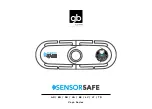
13
LDB-ST1LE Batcher
5.3.5 RS-232 Serial Port Operation in Rate/Total mode
The RS-232 serial port can be used for programming (using the Setup Disk) or for communicating to printers
and computers in the Operating Mode (Run Mode).
PC Communications:
The Setup Disk also allows the user to query the unit for operating status such as Flow Rate, Flow Total,
Presets, etc.
Operation of RS-232 Serial Port with Printers:
Transaction Printing
For transaction printing, the user defines the items to be included in the printed document (see section
6.3.20 SET DATA OUTPUT, Select_list). The transaction document can be initiated by pressing the PRINT
key or by a remote contact closure.
Data Logging
In data logging, the user defines the items to be included in each data log (see section 6.3.20 SET PRINTER
OUTPUT, Select_list). The user can also select when (time of day) or how often (print interval) the data
log is to be made (see section 6.3.19 SET PRINTER OUTPUT, Configure).
System Setup and Maintenance Report
The system setup and maintenance report lists all of the instrument setup parameters and usage for the
current instrument configuration. The audit trail information and a status report is also printed. This report
is initiated in the Test menu (see section 8.2.3 PRINT SYSTEM SETUP).
5.3.6 RS-485 Serial Port (optional)
RS-485 Port Description:
The optional RS-485 card utilizes Modbus RTU protocol to access a variety of process
parameters and totalizers. The Relays can be controlled via Modbus. In addition, action
routines can be executed. For further information, contact factory and request RS-485 Protocol
manual.
Operation of Serial Communication Port with PC
The flow computer's RS-485 channel supports a number of Modbus RTU commands. Modbus
RTU drivers are available from third party sources for a variety of Man Machine Interface
software for IBM compatible PC's.
The user reads and writes information from/to the RS-485 using the Modbus RTU commands.
The LDB-ST1LE then responds to these information and command requests.
Process variables and totalizers are read in register pairs in floating point format. Time and
date are read as a series of integer register values. Alarms are individually read as coils. Action
routines are initiated by writing to coils.
















































